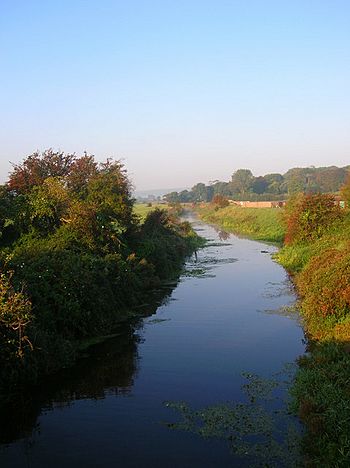Glynde Reach facts for kids
Quick facts for kids Glynde Reach |
|
|---|---|

Glynde Reach near Glynde
|
|
| Country | England |
| County | East Sussex |
| Villages | Beddingham, Glynde, Ringmer, Laughton, Ripe, Selmeston |
| Physical characteristics | |
| Main source | Selmeston, East Sussex, UK 50°50′37″N 0°08′25″E / 50.843594°N 0.140326°E |
| River mouth | River Ouse UK 50°50′52″N 0°02′18″E / 50.847698°N 0.038201°E |
| Length | 7.75 mi (12.47 km) |
Glynde Reach is a river in East Sussex, England and tributary of the River Ouse. The main channel is fed from sources near Laughton, Rushy Green on the outskirts of Ringmer, two streams near Selmeston and several near Ripe.
History
Glynde Reach and the River Ouse were almost certainly a tidal inlet at the time the Domesday book was produced in 1086. The main industry was the production of salt by the evaporation of sea water, and salt works were recorded at Ripe and Laughton. During the early 14th century, meadows were created on parts of the flood plain by building embankments, but conditions worsened later in the century. Meadows at Beddingham were flooded in the summer for five years in the 1360s and three in the 1380s, but not at all in the 1370s. The state of the land was affected by the state of the Ouse, and reductions in the volume of water to scour the main outlet at Newhaven as a result of the embanking resulted in a large shingle bar forming, and the mouth moving eastwards to Seaford. Consequently, conditions on the floodplain, known as the Lewes and Laughton Levels, worsened. Some 400 acres (160 ha) of meadow owned by the Archbishop of Canterbury near the junction of the Glynde Reach and the Ouse became a permanent fishery called the Brodewater in the 15th century.
In 1537, after the Prior of Lewes and various riparian landowners had consulted with Dutch drainage engineers, the Commissioners of the Levels raised a water scot, levied on all whose land was threatened by flooding, and by 1539 had cut a new outlet channel for the River Ouse through the shingle bank at Newhaven. The improved drainage benefitted the levels, enabling the Archbishop of Canterbury's Brodewater to revert to meadow, and it was still in use as such in 1616. Conditions worsened later in the 17th century, again connected with the deteriorating outlet to the Ouse, and so the Commissioners for the Levels employed the engineer John Smeaton to carry out a survey and recommend solutions. He visited the area on four days in June 1767, after a period of wet weather, to inspect the meadow lands, locally known as brooks. He found that the brooks at Ranscombe, near the junction between Glynde Reach and the Ouse, in common with those to the west of the Ouse, had low and poorly maintained embankments, and at high tide, the water level in the river was above the levels of the meadows. To the east of Ranscombe, the brooks bordering Glynde Reach were generally at a higher level, but were affected by stagnant water lying on the surface. He attributed this to the fact that there was no gradient on the river, which followed a winding course, and was confident that if the issues at Ranscombe could be resolved, those on the Glynde would also be.
He proposed that the River Ouse should be straightened, that embankments should be raised at Ranscombe and to the west of the Ouse, and that a huge sluice should be constructed on the Ouse at Piddinghoe, to prevent tides from entering the river system. By 1768, the Commissioners had implemented some of Smeaton's suggestions, widening the Ouse below Lewes and dredging it to remove the worst shoals, but they did little to straighten the river, and his great sluice was not constructed.

